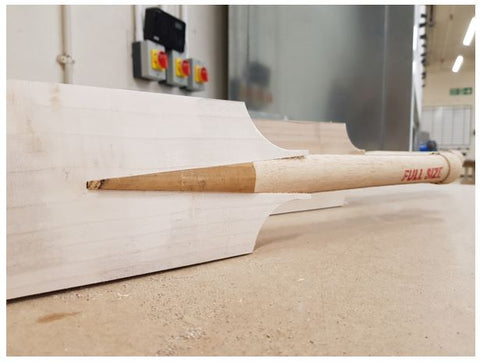The English Willow Cricket Bat

The English Willow has dominated the cricket bat market in international cricket for decades now. Well-seasoned, aged, and treated English willow clefts produce the most lightweight yet power-packed, high quality cricket bats, making them the most popular choice amongst professional players. But what makes the English Willow so desirable and ideal? Why does it stand out above other options like the Kashmir willow?
Well, there are several defining characteristics of the English willow that allows it to excel in performance. Some include:
- The wood source,
- Cutting process,
- Manufacturing process, and
- Its final finishes.
Coming from the Salix Alba Caerulea tree (native to Europe and Western and central Asia), the fast-growing and straight-seamed variety of willow produces wood that is lightweight, yet tough and durable.
- Once the right wood is chosen, the next step is to split the wood into “clefts” which take the rough shape of a bat or “blade”.
- Following the “machining” stage, (and after waxing the ends of the cleft to prevent splitting and the wood drying out), the clefts enter a 9-12 month air-drying period to recalibrate the moisture content and reassess the quality of the bats, giving them quality ratings or “grades” from 1 through to 5 (with 1 being the best). Grade 1 wood is usually the whitest throughout its full surface and with its grain closest together, whereas grades 4-5 typically have a couple of blemishes and inconsistencies throughout their grains.
- The bat can then be moved on to the pressing stage. This is where the willow fibres are compressed at pressures of up to 2000 psi, but this value varies between individual bat makers as it is a matter of experience and personal judgement. If there is too little pressure applied at this stage, then the bat it sure to snap when used in games, but if too much pressure is applied, then the wood will become unworkable. These high pressures are needed to replicate the force exerted on the blade when a ball makes impact with it at high velocities. To be able to consistently withstand it, this pressing stage is given utmost importance (as is the “knocking-in” stage in post-production). Knocking-in the bat involves striking the blade of the bat with a cricket bat mallet or an old cricket ball. This increases the density of the soft fabrics within the bat, which reduces the risk of your bat snapping while training or in a game. Using raw linseed oil is also used sometimes to fill in the gaps between the fibres.
- Then we come to the splicing of the handle onto the cleft. The handle is usually a long, cylindrical, cane, covered by an appropriate material (rubber) that allows for a firm, sturdy grip. The selection of cane for the bat’s handle is equally as important as the wood for the blade itself. This is because the handle needs to be weighted suitably, such that it offers the perfect counterbalance to the weight of the bat itself, making it very comfortable to pick up and swing while playing your shots! Furthermore, it is ensured that the handle is set slightly forward of the blade for optimal pick-up, secured with a water-resistant wood glue, and left overnight to dry. The final stages involve hand shaping, sanding, binding of the handle, polishing, and labelling.

But what makes English Willows so superior in general to Kashmir willow? Kashmir willow clefts typically do not have straight, identical grains like the English counterpart. Furthermore, because of the region in India from which the wood is taken from, the clefts are a lot denser and thus heavier too and with a hard general structure. The distribution of the grains themselves are much more scattered, whereas the English Willow has a very structured and compact grain distribution. Most Kashmir willows generally have smaller sweet spots and a relatively low “ping” off the bat compared to the English, however due to these imperfections, they do come at a much cheaper price to professional English Willow based bats.
Don’t be mistaken though! Although the Kashmir Willow may not be parallel in quality to the English Willow, it is still great value for money and at a much more affordable price. It is ideally suited to beginner cricketers just playing their first few seasons of cricket. Its heavier nature could even be used advantageously; as it forces players to focus on their core strength to solidify their stance, skills, and technique.
We at CA Sports ensure that the entire bat-making process is immaculately covered with great attention to detail. The special touch we add to the bats with our aesthetic CA Sports Sticker widens the gap just that extra amount that puts us a class apart from the rest.

